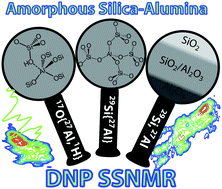Shedding light on the atomic-scale structure of amorphous silica–alumina and its Brønsted acid sites†
Abstract
In spite of the widespread applications of amorphous silica–aluminas (ASAs) in many important industrial chemical processes, their high-resolution structures have remained largely elusive. Specifically, the lack of long-range ordering in ASA precludes the use of diffraction methods while NMR spectroscopy has been limited by low sensitivity. Here, we use conventional as well as DNP-enhanced 29Si–29Si, 27Al–27Al, and 29Si–27Al solid-state NMR experiments to shed light on the ordering of atoms in ASAs prepared by flame-spray-pyrolysis. These experiments, in conjunction with a novel Monte Carlo-based approach to simulating RESPDOR dephasing curves, revealed that ASA materials obey Loewenstein's rule of aluminum avoidance. 3D 17O{1H} and 2D 17O{1H,27Al} experiments were developed to measure site-specific O–H and HO–Al distances, and show that the Brønsted acid sites originate predominantly from the pseudo-bridging silanol groups.



 Please wait while we load your content...
Please wait while we load your content...